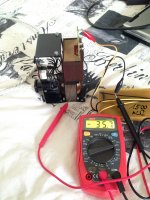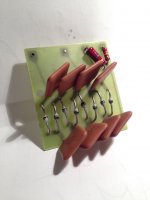Dear Forum,
Recently, I've discovered that one side's bass panels (both) started to sound distorted in a way. Both panels are involved at the same time, so it likely could be some kind of transformer problem, too in my opinin.
Does anybody here encountered any faults similar to this?
I've linked a video here (I had no luck attaching any audio or video files here at the forum)
I hope the sound fault comes through clearly as I cannot describe it more precisely than a 'distortion'
Thank you for your help in advance!
Recently, I've discovered that one side's bass panels (both) started to sound distorted in a way. Both panels are involved at the same time, so it likely could be some kind of transformer problem, too in my opinin.
Does anybody here encountered any faults similar to this?
I've linked a video here (I had no luck attaching any audio or video files here at the forum)
I hope the sound fault comes through clearly as I cannot describe it more precisely than a 'distortion'
Thank you for your help in advance!
Here are a couple of suggestions - whether they're worth anything I don't know.
Try to test the two loudspeakers with pink or white noise. If the tonal balance of the two is identical it is not very likely that it is a transformer fault. (Do it one loudspeaker at a time - and preferably place them close to each other. Any difference will be immediately discernible.)
The distortion sounds very much like an EHT-leak. However, this is quite unlikely UNLESS
s the dustfilm is broken (and has been for some time) so that dust has gathered and been sucked into the diaphragm. So, check the the dustfilms. One other possibilty: If for some reason the diaphragm has become loose or lost tension it is possible for it to get so close to the stators that a spark can occur. However, it is not very likely that that should have happened to both panels. Yet a third thing to check: any loose connections?
There are some 180 kOhm resistors in series with the stators - could there be an arch-over there?
Good luck - I hope you find the fault.
Try to test the two loudspeakers with pink or white noise. If the tonal balance of the two is identical it is not very likely that it is a transformer fault. (Do it one loudspeaker at a time - and preferably place them close to each other. Any difference will be immediately discernible.)
The distortion sounds very much like an EHT-leak. However, this is quite unlikely UNLESS
s the dustfilm is broken (and has been for some time) so that dust has gathered and been sucked into the diaphragm. So, check the the dustfilms. One other possibilty: If for some reason the diaphragm has become loose or lost tension it is possible for it to get so close to the stators that a spark can occur. However, it is not very likely that that should have happened to both panels. Yet a third thing to check: any loose connections?
There are some 180 kOhm resistors in series with the stators - could there be an arch-over there?
Good luck - I hope you find the fault.
Thank you for your help. Well, I am quite sure that this must be some kind of leakage or EHT failure, can't be the dustcovers as I've just refurbished both speakers with brand new dustcovers, and I sealed it tight and nice.
This problem's present both bass panels at the same time, maybe this could be a lead..
It almost sounds like when you plug off the speaker and leave it to discharge: I remember experimenting unplugging the speakers before. While music was playing, the sound of the speaker first became weaker and then distorted before completely disappeared. And this distortion sounds almost the same with the only difference that the speaker is plugged in. If I leave it energized for a week the failure is still there. The treble sounds strong and nice, so it's maybe the multiplier. Could it be an EHT problem (faulty unit) or could the coating evaporate at a level, that cause symptoms like this?
This problem's present both bass panels at the same time, maybe this could be a lead..
It almost sounds like when you plug off the speaker and leave it to discharge: I remember experimenting unplugging the speakers before. While music was playing, the sound of the speaker first became weaker and then distorted before completely disappeared. And this distortion sounds almost the same with the only difference that the speaker is plugged in. If I leave it energized for a week the failure is still there. The treble sounds strong and nice, so it's maybe the multiplier. Could it be an EHT problem (faulty unit) or could the coating evaporate at a level, that cause symptoms like this?
Last edited:
... Well, I am quite sure that this must be some kind of leakage or EHT failure, can't be the dustcovers as I've just refurbished both speakers with brand new dustcovers, and I sealed it tight and nice...
How long ago? Old ESL57 can take up to a day or 2 to fully charge.
Did you do a good cleaning of all the wiring inside? Accumulated debris can act as a bypass for the EHT.
Did you do a in-depth check of all the solderings from the EHT unit to the panel? The Quad manual suggests all solderings should be rounded (like a bead) to prevent Corona effect.
If none of the above applies, you're out of luck: it could be a faulty EHT unit (easy fix), or the bass panels (much harder). Maybe you can disconnect one of the 2 to see if a faulty one is shorting the EHT to both.
How long ago? Old ESL57 can take up to a day or 2 to fully charge.
Did you do a good cleaning of all the wiring inside? Accumulated debris can act as a bypass for the EHT.
Did you do a in-depth check of all the solderings from the EHT unit to the panel? The Quad manual suggests all solderings should be rounded (like a bead) to prevent Corona effect.
If none of the above applies, you're out of luck: it could be a faulty EHT unit (easy fix), or the bass panels (much harder). Maybe you can disconnect one of the 2 to see if a faulty one is shorting the EHT to both.
Last year. I was as careful and precise as I could, regarding soldering tasks, too.
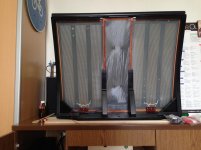
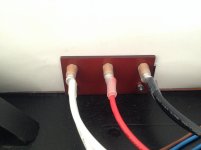
Maybe, or maybe build a probe with 5-10 giga-ohms resistor.
Or rebuild the whole EHT unit: only fairly standard parts inside.
Great job, very clean units. I'd do a few more runs of hair dryer to fully tension the tweeter dust cover, but this is not related to your problem.
Or rebuild the whole EHT unit: only fairly standard parts inside.
Great job, very clean units. I'd do a few more runs of hair dryer to fully tension the tweeter dust cover, but this is not related to your problem.
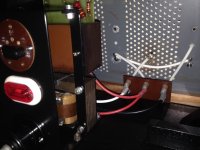
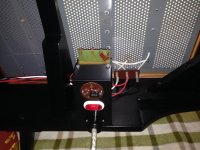
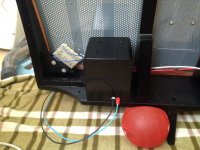
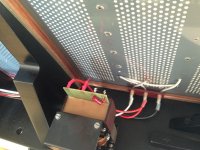
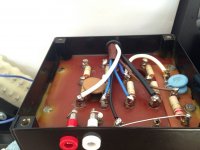
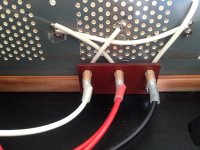
This is the actual unit, carefully insulated, and soldered. The EHT block was completely rebuilt (new Philips diodes, but caps are the factory ceramic ones) and tested with a voltage divider and DVM, so I don't think it's the EHT, but who knows?
I've streched the covers, certainly.
I still assume that it's the bass panels coating, or a leakage somewhere inside the panel. I had a problem with the other unit, the panel was discharging 'loudly' with pops, but I managed to put an end to it by screwing in more the two bolts holding the phenolic terminal board at the bottom.
Last edited:
Oh well, you certainly did everything there is to do, and, sadly, the culprits are the bass panels themselves. You can either attempt to rebuild them (big deal), or buy replacement panels (big €). 
My very first ESL57 came from a junk yard and it was in terrible shape: torn dust covers, long exposure to dust, and so on. It wouldn't charge at all. I used a vacuum cleaner to suck all the debris through the holes, and, surprisiingly, it worked. You may want to try this if all else fail.
My very first ESL57 came from a junk yard and it was in terrible shape: torn dust covers, long exposure to dust, and so on. It wouldn't charge at all. I used a vacuum cleaner to suck all the debris through the holes, and, surprisiingly, it worked. You may want to try this if all else fail.
Yes.
Did you do measurements with the EHT wired to the woofers? What kind of voltage did you get?
No, I haven’t done anything like this yet. I am not sure that this measurement requires an electrostatic voltmeter, or can be done with this voltage multiplier.
Less troublesome is to swap L/R EHT blocks and see if the problem moves too.
I will try this first as soon as I’ll have time
Last edited:
Maybe you need a bigger resistor, like 5 to 10 GOhms. It'll let you see if a panel is shorting/overloading the EHT before you do any swap.
Could you give me instructions how should I determine it with the 5-10 resistor?
First, let's assume your digital multimeter (DVM) has an input impedance of 10 Meg, which is usually the case. Then, let's assume you're buying 2 x 5 Giga resistors like those in a previous reply, and connect them in serie to form a 10G resistor.
The 10G resistors in serie with the 10M of your multimeter forms a voltage divider of about 1000:1, so the nominal 6000V EHT should read 6V on your DVM.
Step by step:
- solder the two 5G resistors
- set your DVM to 10V or 20V DC range
- connect the black lead of your DVM to the frame of the power unit
- connect the red lead of your DVM to one end of your 10G composite resistor
- touch the other end of the 10G resistor to the thick red wire of the EHT unit
The reading could be a bit lower than the 6V nominal due to the loading of the probe.
If you haven't done so already, read Shedon's bible for more detail, or this one for a simplified procedure.
The 10G resistors in serie with the 10M of your multimeter forms a voltage divider of about 1000:1, so the nominal 6000V EHT should read 6V on your DVM.
Step by step:
- solder the two 5G resistors
- set your DVM to 10V or 20V DC range
- connect the black lead of your DVM to the frame of the power unit
- connect the red lead of your DVM to one end of your 10G composite resistor
- touch the other end of the 10G resistor to the thick red wire of the EHT unit
The reading could be a bit lower than the 6V nominal due to the loading of the probe.
If you haven't done so already, read Shedon's bible for more detail, or this one for a simplified procedure.
First, let's assume your digital multimeter (DVM) has an input impedance of 10 Meg, which is usually the case. Then, let's assume you're buying 2 x 5 Giga resistors like those in a previous reply, and connect them in serie to form a 10G resistor.
The 10G resistors in serie with the 10M of your multimeter forms a voltage divider of about 1000:1, so the nominal 6000V EHT should read 6V on your DVM.
Step by step:
- solder the two 5G resistors
- set your DVM to 10V or 20V DC range
- connect the black lead of your DVM to the frame of the power unit
- connect the red lead of your DVM to one end of your 10G composite resistor
- touch the other end of the 10G resistor to the thick red wire of the EHT unit
The reading could be a bit lower than the 6V nominal due to the loading of the probe.
If you haven't done so already, read Shedon's bible for more detail, or this one for a simplified procedure.
This is a voltage divider essentially, then. This measures the ‘health’ of the EHT unit, but we cannot determine the state of the woofers, can we?
- Status
- This old topic is closed. If you want to reopen this topic, contact a moderator using the "Report Post" button.
- Home
- Loudspeakers
- Planars & Exotics
- QUAD ESL 57: strange sound from a (faulty?) bass panel
